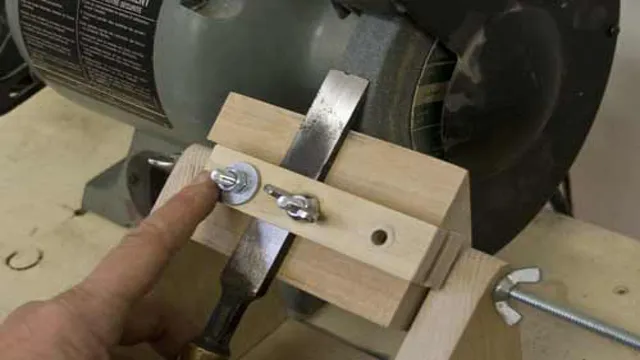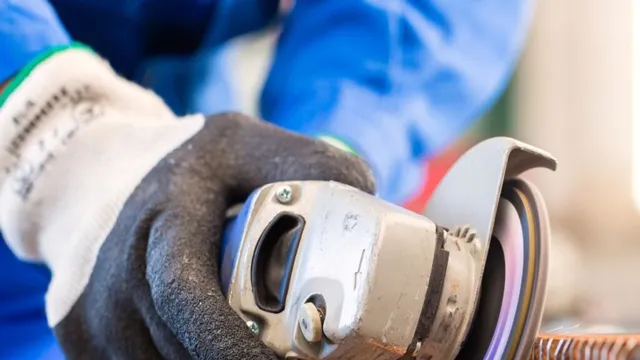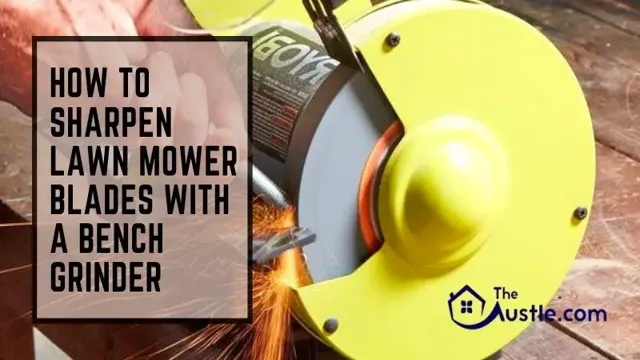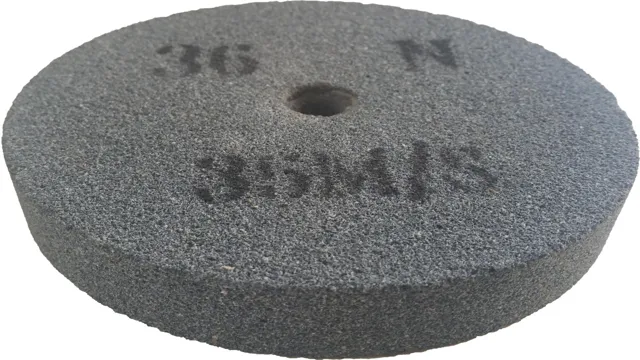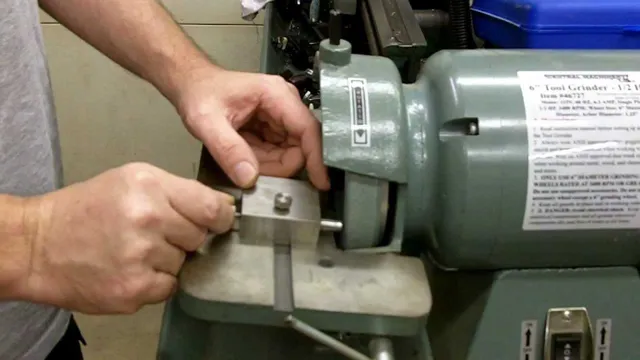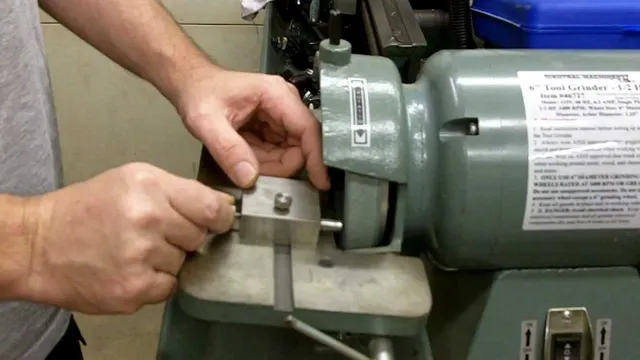Can a Bench Grinder be Used as a Buffer? Benefits of Converting Your Grinder into a Buffer.
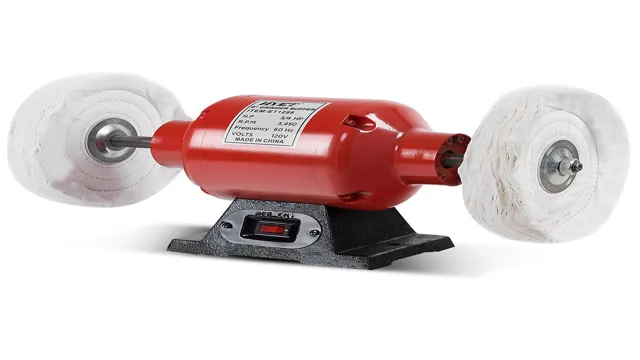
Are you someone who likes to keep their tools versatile and multi-functional? Have you ever wondered if you could use your bench grinder as a buffer? Well, wonder no more. With a few simple modifications and some know-how, you can turn your bench grinder into a buffer and get your polishing tasks done in no time. Buffing is an essential part of many metalworking projects, from car restoration to jewelry making.
However, buying a separate buffer can be expensive, especially if you only need it for occasional use. That’s where using your bench grinder can come in handy. While a bench grinder is typically used for grinding, sharpening, and shaping metal, it can also be adapted to buff and polish metals, plastics, and even wood.
To turn your bench grinder into a buffer, you’ll need to make some modifications. First, you’ll need to remove the grinding wheels and replace them with buffing wheels. You’ll also need to adjust the speed settings and use the right compounds and polishing pads.
With a little practice, you can get your bench grinder working like a professional buffer, giving your metalwork a high-quality finish and a mirror-like shine. So, why spend money on a separate buffer when you can DIY with your bench grinder? With the right techniques and equipment, you can save money, time, and effort, and get the satisfaction of doing it yourself. In this blog, we’ll guide you through the process of using a bench grinder as a buffer, from selecting the right wheels to polishing tips and tricks.
Get ready to take your polishing skills to the next level and let’s dive in!
Key Differences Between a Bench Grinder and a Buffer
Many people wonder if a bench grinder can be used as a buffer, but the truth is that while they have some similarities, they are actually quite different tools with different purposes and functions. The key difference between a bench grinder and a buffer is that a grinder is designed to remove material and sharpen or grind tools, while a buffer is designed to polish and smooth surfaces. Grinders typically have abrasive grinding wheels or discs, while buffers have soft buffing and polishing pads.
Additionally, buffers typically run at higher speeds than grinders, so using a grinder as a buffer could potentially cause damage to the surface being buffed. While there may be some instances where a grinder could be used as a buffer for very specific applications, it is not recommended or advisable to do so. If you need to both grind and buff materials, it is best to invest in both tools separately.
Size and Shape
When it comes to metalworking or woodworking, two common tools to have in your arsenal are a bench grinder and a buffer. These two tools may seem similar at first glance, but they have key differences that set them apart. One of the most noticeable differences is their size and shape.
A bench grinder typically has a larger, bulkier build with two grinding wheels on either end of a motor. Meanwhile, a buffer is often smaller and shaped like a handheld power tool, with a single buffing wheel or pad. The size and shape of these tools can affect their functionality and the types of projects they are best suited for.
For example, a bench grinder is more powerful and better equipped for heavy material removal and sharpening, while a buffer is ideal for creating a smooth, polished finish on surfaces. Understanding the differences between these tools is essential for selecting the right tool for your specific project needs.
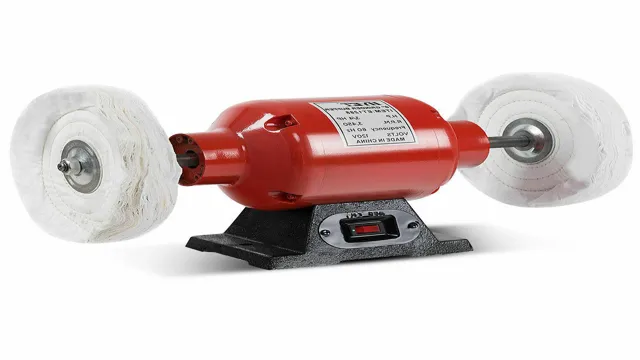
Speed
When it comes to grinding and polishing tasks, a bench grinder and buffer can appear quite similar at first glance. However, there are a few key differences worth considering. One of the most significant differences between a bench grinder and a buffer is speed.
Bench grinders are typically designed to operate at higher speeds, making them ideal for rough grinding and sharpening tasks. Buffers, on the other hand, are designed to operate at lower speeds, making them better suited for polishing and buffing applications. The speed of a bench grinder can be adjusted by changing the wheel size, whereas buffers typically have a set speed.
It’s essential to choose the right tool for the job, as using a bench grinder for buffing tasks, or a buffer for grinding tasks, can result in damage to both the tool and the workpiece. By understanding the differences between these two tools, you can select the appropriate tool for your specific needs and achieve the best possible results.
Power
When it comes to power tools for your workshop, two popular options are the bench grinder and the buffer. While both share similarities with their rotating wheels and motors, there are key differences to keep in mind. A bench grinder is a powerful tool that is designed for heavy-duty grinding, sharpening, and shaping of metal objects, while a buffer is a lighter tool that is more suited for the final polishing of surfaces, such as car paint or furniture.
In terms of power, a bench grinder typically has a higher horsepower and operates at a higher speed, making it better for tough jobs. On the other hand, a buffer is designed for precision and finesse, with a lower speed and lower horsepower. When choosing between the two, consider the specific tasks you will be performing and the level of power you need for a quality job.
How to Use a Bench Grinder as a Buffer
If you’re wondering, “can a bench grinder be used as a buffer?” the answer is yes! In fact, a bench grinder can be a great substitute for a traditional buffer, and it’s much more affordable. All you need is a buffing wheel attachment and a polishing compound to get started. However, it’s important to note that the grinder may not have the same motor power as a dedicated buffer, so you’ll need to be mindful of applying too much pressure, as the motor may overheat.
Also, keep in mind that the buffing wheel needs to be properly secured to the grinder, to avoid any accidents while in use. With a steady hand and some patience, a bench grinder can effectively buff and polish metals, plastics, and other materials.
Choose Your Grinding Wheel
If you want to use your bench grinder as a buffer, the first thing you need to do is choose the right type of grinding wheel. You’ll want to select a wheel that is made of a material that’s soft enough to prevent damage to your workpiece, but still hard enough to effectively polish and buff the surface. A fine-grit aluminum oxide or silicon carbide wheel is a good option for most buffing projects, as it can provide the right level of smoothness and shine without causing scratches or other imperfections.
Once you’ve selected the right wheel, you’ll need to attach it to your bench grinder. Most bench grinders come with arbors and nuts for securing the grinding wheel in place, so make sure to follow the manufacturer’s instructions carefully. To use your bench grinder as a buffer, you’ll need to apply a polishing compound to the surface of your workpiece.
This will help to remove any scratches or blemishes and create a smooth, glossy finish. Simply rub the compound onto the surface of the workpiece and then buff it with the grinding wheel using a light, circular motion. It’s important to keep in mind that using a bench grinder as a buffer can be dangerous if proper safety precautions aren’t taken.
Always wear eye protection, gloves, and other safety gear when using the machine, and be sure to keep your fingers and other body parts away from the rotating grinding wheel. With the right grinding wheel and a little bit of practice, you can easily use your bench grinder as a buffer to bring out the shine in your workpieces. So why not give it a try and see what kind of professional-looking results you can achieve?
Prepare the Bench Grinder
If you’re thinking of using a bench grinder as a buffer, there are a few preparations you need to make to ensure a smooth and successful process. First, you’ll need to make sure the grinder is clean and free of debris, as any excess dirt or dust can damage the buffer pad or cause it to wear down more quickly. You’ll also want to remove any wire brushes or other attachments, and use a polishing compound or wax to lubricate the buffer pads.
It’s important to wear protective gear such as gloves, a respirator, and safety glasses, as the heavy rotation of the grinder can cause dust and debris to fly around. You should also make sure to use an appropriate speed for your buffer pad, as too much speed can cause the pad to wear down too quickly or cause an uneven finish. With these preparations in place, using a bench grinder as a buffer can be a great way to achieve a high-quality polished finish on your workpieces.
Attach the Buffing Wheel
One of the most common uses of a bench grinder is to turn it into a buffer. Buffing wheels are easy to install and are perfect for polishing and shining metal objects. To attach the buffing wheel, you first need to remove the grinding wheel.
You should also make sure that the bench grinder is unplugged before starting. After removing the grinding wheel, attach the buffing wheel by screwing it onto the threaded spindle. Make sure that it is tight enough to prevent any wobbling during use.
Once the buffing wheel is securely fastened, you can plug in the bench grinder and turn it on. Hold your metal object firmly against the buffing wheel and move it back and forth until you achieve the desired shine. Remember to maintain a steady pressure while buffing and be cautious of any flying debris that may come off the object during the process.
By following these simple steps, you can easily turn your bench grinder into a buffing machine and achieve professional-looking results.
Begin Buffing
If you have a bench grinder lying around in your garage or workshop, you may be surprised to learn that it can be used as a buffer as well. Buffing is the process of polishing metal or wood to give it a shiny and smooth finish. Using a bench grinder as a buffer may take a little bit of practice, but once you get the hang of it, it can save you both time and money.
The key to using a bench grinder as a buffer is to use the correct buffing wheel. Typically, a cotton or felt wheel is used to apply polishing compounds to a surface. These compounds will remove any scratches and give the surface a glossy finish.
One important thing to keep in mind is that you should always be careful when buffing. Make sure the surface you are buffing is clean and free of debris to avoid scratches and other damage. With a little bit of practice and some patience, you can use your bench grinder to give your metal or woodwork a professional-looking finish.
Safety Precautions
Can a bench grinder be used as a buffer? This is a common question among DIY enthusiasts who are looking for a tool that can perform both grinding and polishing tasks. While a bench grinder can be used as a buffer, it is important to note that it is not specifically designed for the job. Using a bench grinder as a buffer can cause serious injuries to the user as the high speed of the grinder requires strict safety precautions to be taken.
It is recommended to use a dedicated buffer for polishing and buffing tasks as it is safer and provides better results. If you are trying to save money on buying a separate buffer, it is recommended to invest in a multi-purpose tool that can do both. However, if you do decide to use a bench grinder as a buffer, make sure to wear protective gear, keep your work area well-lit, and follow all safety guidelines carefully.
Wear Protective Gear
When it comes to risky activities or challenging jobs, wearing protective gear is vital to ensure safety. Whether you’re a construction worker, biker, or hard-core skater, protective gear can help minimize the risks and protect you from injuries. Helmets, safety glasses, gloves, earplugs, and respirators are just a few examples of protective gear that can help protect you against physical and chemical hazards.
Wearing protective gear is essential because it provides a crucial layer of protection that can mean the difference between a minor injury and a life-altering accident. Therefore, it is essential to choose the right protection that suits your needs. For instance, helmets for cycling and skating should fit snuggly and meet the safety standards set by the relevant organizations.
Similarly, when choosing gloves, ensure they are abrasion-resistant, cut-resistant, and sturdy. Adequate safety gear can help protect you from hazards and ensure you work or play safely.
Have a Clear Work Space
When it comes to working in a physical space, safety should always come first. This is especially important when you’re dealing with machinery or equipment that can cause harm if not handled properly. One of the best ways to ensure safety in your workspace is to keep it clean.
You want to minimize clutter and distractions, so you can focus on the task at hand. Tripping over boxes or cords could lead to serious injury. Additionally, having a clear work area helps you to be more organized, which means you’re less likely to lose tools or materials – another way to prevent accidents.
By keeping your workspace tidy and well-organized, you can maximize efficiency and productivity while minimizing the risk of harm or injury. Remember – a clean workspace is a safe workspace!
Avoid Overheating the Motor
When using a motor, it’s important to take safety precautions to avoid overheating. One of the primary causes of motor failure is overheating, which can result in costly repairs or even replacement. To prevent this, always ensure that the motor’s ventilation system is clear of any obstructions and that it’s not being operated in surroundings that are too hot.
Regular maintenance is also key to keeping your motor at optimal performance and preventing overheating. Additionally, if the motor is being used for an extended period of time, it’s important to give it time to rest to prevent overheating. By following these simple safety precautions, you can ensure that your motor stays cool and runs efficiently, prolonging its lifespan and saving you from costly repairs.
Final Thoughts
If you’re wondering whether a bench grinder can be used as a buffer, the answer is yes, technically speaking. However, there are a few things to consider before attempting it. First and foremost, make sure that the bench grinder you’re using has a buffer wheel attachment.
This is usually a softer, fluffier wheel than the typical grinding wheel, which is essential for buffering. Additionally, you’ll need to make sure that the bench grinder is firmly secured to a work surface, as it can be quite powerful and generate a lot of vibration when in use. Finally, keep in mind that bench grinders are primarily designed for grinding and sharpening, not buffing and polishing, so don’t expect the same level of precision and finesse that a dedicated buffer would provide.
Overall, while it is possible to use a bench grinder as a buffer, it’s not necessarily the best option for achieving a professional-grade finish.
Conclusion
In conclusion, while it may be technically possible to use a bench grinder as a buffer, it’s akin to trying to use a hammer to fix a watch. Sure, it may work in a pinch, but it’s not the most effective or efficient method. Real buffers are designed with specific materials and mechanisms to produce a smooth, polished finish without any risk of damaging your workpiece.
So unless you enjoy the smell of burnt metal and the feeling of your hands vibrating for hours, we recommend investing in a proper buffer for all your polishing needs.”
FAQs
What is the difference between a bench grinder and a buffer?
A bench grinder is designed for grinding and sharpening while a buffer is meant for polishing and buffing.
Can a bench grinder be used as a buffer?
It is not recommended to use a bench grinder as a buffer as they have different functions and speeds.
What accessories are needed to convert a bench grinder into a buffer?
To convert a bench grinder into a buffer, you will need buffing wheels, polishing compounds, and adapters.
Is it possible to use a buffer for grinding and sharpening?
No, buffers are not designed for grinding and sharpening as they don’t have the right speed and power to do so.
What is the ideal speed for a buffer?
The ideal speed for a buffer depends on the type of material being buffed, but generally, it should be between 1,500 to 3,000 RPM.
Can a buffer also be used for sanding?
Yes, a buffer can be used for sanding with the appropriate sanding disc attachment.
What safety measures should be taken when using a buffer?
Wear protective gear such as safety goggles, gloves, and a dust mask. Also, avoid wearing loose clothing and tie back long hair to prevent getting caught in the machine.

